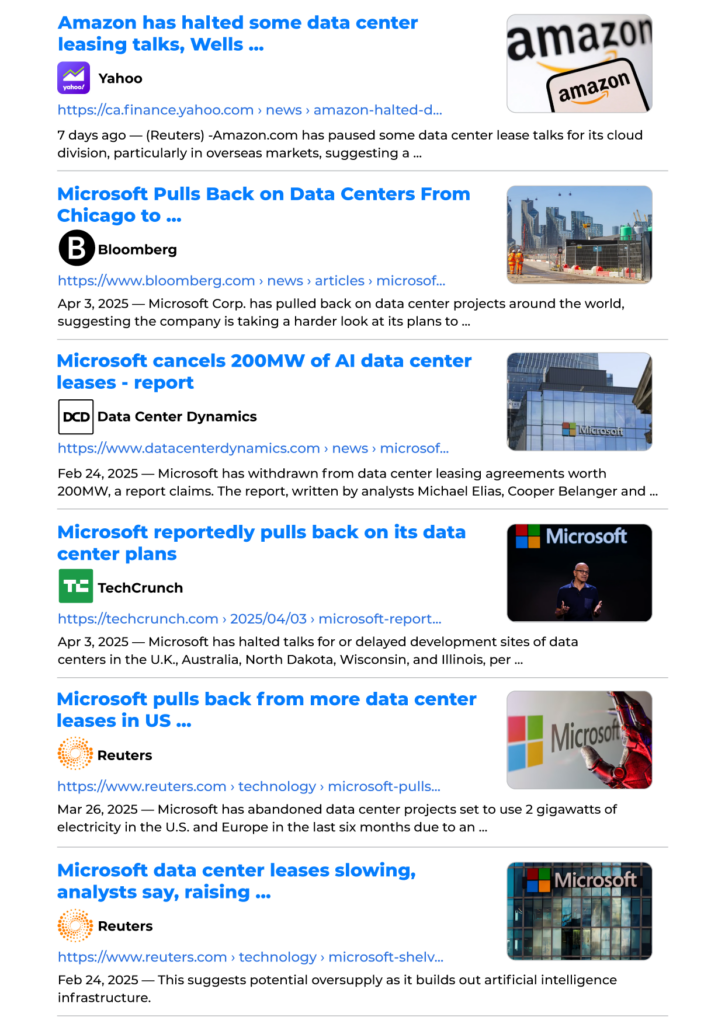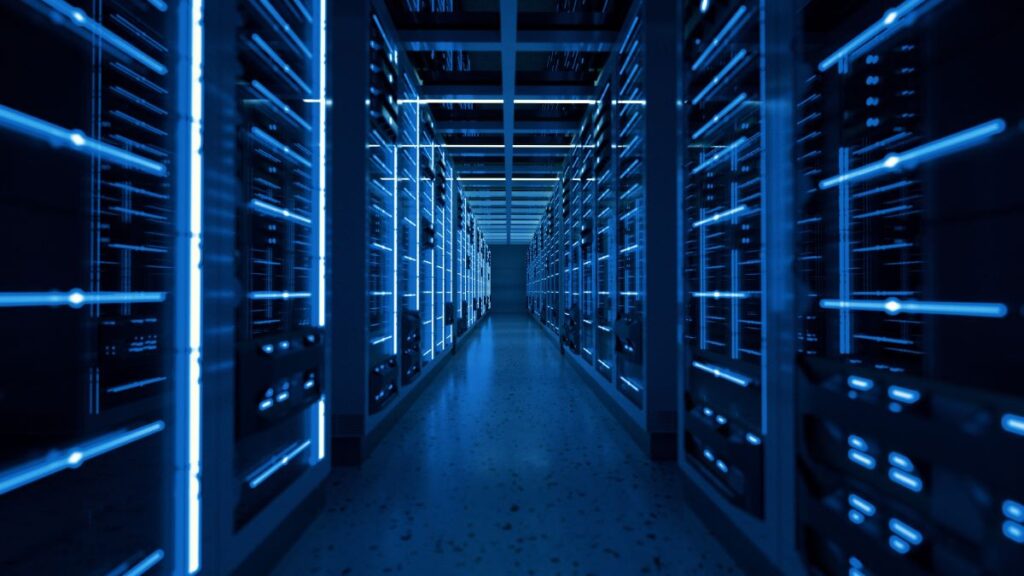
In spite of the media’s relentlessly desperate desire to screech that the sky is falling, recent reports of data center overbuilds and scaling-back hyperscalers are proving to be wildly inaccurate as AWS, Google Cloud, Microsoft, and Oracle are fully committed to pour about $300 billion into AI and cloud infrastructure in 2025.
While it is 100% true that both Microsoft and AWS have revealed that they’ve adjusted plans for a tiny number of facilities — and you’ll see both of those mentioned (and blown way out of proportion) in the Google Search examples I’ve pasted below — it is a pure and unadulterated hallucination to extrapolate from those reports that the four hyperscalers have overbuilt for the AI Revolution (quite the opposite is true) and are continuing to overbuild (that is utter nonsense).

As I see it, the four hyperscalers are all proceeding pretty much full-speed ahead, with that full-tilt acceleration including some refinements on the fly as each company performs advance planning forecasts and buildouts on an unprecedented scale and is, here and there, course-correcting along the way.
In assessing which of the hyperscalers is being most aggressive in its buildout of additional AI and cloud data center capacity, I’d rank them this way:
1. Oracle. It has far more cloud regions than any other hyperscaler, it is continuing to build out more at a dizzying pace, and it is deploying a unique architecture that enables it to build data centers that are much smaller and less expensive than those of its competitors.
2. Google Cloud. At the recent Google Cloud Next event, Alphabet CEO Sundar Pichai underscored his company’s plans to continue investing aggressively — including $75 billion in 2025 — in its AI and cloud infrastructure with no slowdowns, pauses, hitches, hangups, or holdouts of any kind.
3. AWS. On the company’s most-recent earnings call in early February, Amazon CEO Andy Jassy said he expects the company to pour $100 billion or more into AI and cloud infrastructure this year. Plus, the recent reports of “pauses” or cutbacks are isolated, limited examples of resources being reallocated to align with emerging needs and priorities.
4. Microsoft. CEO Satya Nadella has pledged to pump $80 billion into infrastructure this year, and later this week the company is likely to report quarterly cloud revenue of more than $40 billion — including perhaps $3 billion from AI — in a fast-growing business where it’s just about inconceivable to expect its infrastructure requirements will slow down.
Now, a little more detail on where three of those hyperscalers stand today with regard to infrastructure ambitions.

AI Agent & Copilot Summit is an AI-first event to define opportunities, impact, and outcomes with Microsoft Copilot and agents. Building on its 2025 success, the 2026 event takes place March 17-19 in San Diego. Get more details.
Oracle
True to the aggressive nature of its hypergrowth Oracle Cloud Infrastructure, Larry Ellison’s company is damning the torpedoes as it aspires to fulfill the prophecy made several weeks ago by CEO Safra Catz when she said, “It’s only a matter of time until we have more cloud regions than all of our competitors combined.”
In an email comment for this article, Oracle OCI executive vice-president Mahesh Thiagarajan said, “We continue to open new cloud regions at a fast clip to meet the growing demand for Oracle Cloud Infrastructure (OCI) and the AI services it supports. Because of how we build our regions, we’re able to pack hyperscale capabilities into smaller footprints, which enables us to put them in locations other cloud providers can’t. Last quarter we surpassed 100 cloud regions, and we plan to continue to expand our footprint of public, dedicated, and multi-cloud regions.”
Google Cloud
In his keynote address at Google Cloud Next earlier this month, Alphabet CEO Sundar Pichai said, “The opportunity with AI is as big as it gets. That’s why we are investing in the full stack of AI innovation, starting with the infrastructure that powers it all. We are making big investments now and into the future. In 2025, we plan to invest around $75 billion in total CapEx. This investment will be directed at servers and data centers, which includes powering our AI and cloud business, so this will greatly benefit all of our customers.”
And on Alphabet’s Q1 earnings call last week, CFO Anat Ashkenazi stated on multiple occasions that Google Cloud had more customer demand for its AI and cloud services than it could supply for the second straight quarter. That exact type of shortfall and the imbalance it reflects between customer demand and available capacity is precisely why these whipped-up claims of “overcapacity” and data-center pullbacks are absurd.
Microsoft
Yes, Nadella has fully committed to investing $80 billion on AI and cloud infrastructure this year. But in a timely and well written LinkedIn post on April 4, Microsoft president of cloud operations and innovation Noelle Walsh, while attempting to explain the need for some on-the-fly adjustments and reallocations of resources and priorities, inadvertently gave the sky-is-falling crowd some details to distort and wildly misinterpret.
Here is the key paragraph from Walsh’s post:
“Recently, we have seen heightened interest in the adjustments we are making to some early-stage datacenter infrastructure projects. While these kinds of shifts are common in rapidly growing industries, I wanted to shed some light on a few of the considerations that helped shape our decision making. Data center planning is a multi-year and capital-intensive program we plan for years in advance to ensure we have sufficient infrastructure in the right places. In recent years, demand for our cloud and AI services grew more than we could have ever anticipated and to meet this opportunity, we began executing the largest and most ambitious infrastructure scaling project in our history. By nature, any significant new endeavor at this size and scale requires agility and refinement as we learn and grow with our customers. What this means is that we are slowing or pausing some early-stage projects. While we may strategically pace our plans, we will continue to grow strongly and allocate investments that stay aligned with business priorities and customer demand.”
So by saying “What this means is that we are slowing or pausing some early-stage projects,” Walsh unwittingly let loose the dogs of data center overcapacity, who while seizing on that one explanatory detail chose to overlook the abundantly clear primary message from Walsh’s post that is captured in this excerpt: “…demand for our cloud and AI services grew more than we could have ever anticipated and to meet this opportunity, we began executing the largest and most ambitious infrastructure scaling project in our history.”
Final Thought
I commend Noelle Walsh for her post and for her crystal-clear explanation of Microsoft’s booming cloud and AI infrastructure plans, and it is unfortunate that some people have chose to misportray her comments so egregiously.
And I certainly commend all of the hyperscalers mentioned here for their commitments to powering the AI Revolution and the remarkable advances it is enabling. Quick — name one other industry into which four leading companies are investing $300 billion in CapEx in a single year, and I’ll give you a few weeks to complete the search.
And remember: the business world’s never seen anything like the Cloud and AI Wars. So, we would all do well to keep our heads up and on the big picture, and not on the ankle-biting nonsense of those who either can’t or won’t.
Ask Cloud Wars AI Agent about this analysis













